|
Michael McFadyen's Scuba Diving - SS Bonnie Dundee
George Wallace Nicoll and his younger brother Bruce Baird Nicoll were sons of a Scottish shipwright who came to Australia in about 1840. The elder Nicoll had a shipyard in Sydney and the younger Nicolls started running ships from Sydney to the Northern Rivers area of Far Northern New South Wales. Apparently they were the first to introduce screw steamers to NSW (replacing sail or paddlewheelers). Part of their business was timber and they used their vessels to move the valuable product to Sydney. Their early vessels included Wallace and Bruce (1869 to 78) and Wallaby. Other ships included the steam power ships Australian, Lismore, Truganni and Richmond.
On 2 March 1877 a new ship was launched by Miss Jane Nicoll, cousin of the owners, from the Gourlay Brothers shipyard in Dundee, Scotland, for G. W. Nicoll of Sydney. I am not sure if this was the name of the Nicolls' company or if it was just Mr George Nicolls. Some reports that the new ship was built for G. and B. Nicoll. The new vessel was named SS Bonnie Dundee after the birthplace of George and Bruce Nicoll, Dundee.
The ship was 39 metres long and 6 metres wide and displaced 121 tons gross. Its was powered by a 40 hp twin cylinder compound steam engine with the steam coming from a single coal burning boiler. A compound engine is one which has different sized cylinders. The high pressure steam first goes into the smaller diameter cylinder and then, when it has expended a lot of its energy and is at a lower pressure, it goes into a far bigger cylinder which enables the steam to still create power this cylinder. It is far more efficient than a simple engine where the steam is used just once (a triple expansion engine is more efficient again). The Bonnie Dundee had two masts and was a coastal cargo and passenger ship to be used mainly on the North Coast of New South Wales, apparently carrying maize from the Richmond River area to Sydney.
The SS Bonnie Dundee sailed from Dundee on 28 March 1877, travelling via the Suez Canal and Ceylon (now Sri Lanka) and arrived in Cooktown on Wednesday 27 June 1877. It was apparently rough between Java Head (in now Indonesia) and Somerset (this was a town at Cape York - it is now a ghost town with virtually no remains at all). At Somerset she took on 13 tons of beche de mer (sea cucumber) and it was off loaded at Cooktown.
On Thursday 12 July 1877 Bonnie Dundee was at anchor off Inskip Point, Wide Bay. On 13 or 14 July 1877, she put into the Clarence River short of coal. It is assumed that she took on coal from another ship or a store on the river.
She finally arrived in Sydney on 18 July 1877. The skipper of the ship was John A. Greig, 47, from Aberdeen, Scotland. The vast majority of the crew on this trip were Scottish. The crew was:
| Name | Position | Age | Home Town |
| John A. Greig | Captain | 47 | Aberdeen |
| W. Ramsay | Mate | 32 | Dundee |
| David Cobb | Boatswain | 45 | Montrose |
| John A. Gunn | First Engineer | 34 | Dundee |
| Malcolm McDowell | Asst Engineer | 21 | Belfast |
| Thomas Souter | Third Engineer | 24 | Dundee |
| John Jackson | Fireman | 24 | Bathgate |
| George McIntosh | Fireman | 44 | Dundee |
| Alex McLaren | Fireman | 27 | Lockie |
| Samuel Thorburn | Cook and Steward | 48 | Isle of Rum |
| David Souter | Able Seaman | 24 | Dundee |
| James Rattray | Able Seaman | 30 | Dundee |
| Matthew Campbell | Able Seaman | 34 | Dundee |
| David Heare | Able Seaman | 44 | Montrose |
On board was a passenger, Mr K. G. Erolis who was from Ceylon.
The ship was registered in Sydney and given the Lloyd's of London number 75200. She entered service, presumably almost immediately.
On 17 May 1878 the Bonnie Dundee was towing the Rob Roy out of the Clarence River when the tow line broke. The Rob Roy ran aground and was dismantled over the next month.
At 4:15 pm on Thursday 28 November 1878 the Bonnie Dundee left Sydney for Brisbane under the command of Captain J. A. Stuart. It was supposed to arrive on Friday 29 and then Saturday 30 November 1878. It actually arrived at the Bright Brothers Wharf at 11 am on Sunday 1 December 1878. On board were Sydney. Mrs Morton and family, Messrs. T. A. Board, A. L. Morisset, T. W. Sheehan, Herson, Jones, and 6 passengers in the steerage. She also brought the mail from Sydney that had originated in San Francisco, USA.
On Tuesday 3 December 1878 the Bonnie Dundee left Brisbane for the Richmond River and Sydney. When she left Brisbane she only had ballast on board. She arrived in Sydney on 9 December 1878.
At 12.30 pm on 10 March 1879, the SS Bonnie Dundee left Sydney bound for the Manning River (Taree is on the Manning). The skipper was Captain J. Alexander Stuart and there was a crew of 21 crew on board, one of whom was a female steward. There were at least three female passengers. At about 6 pm, she was off the Central Coast of New South Wales making her way north from Sydney and the Mate, Thomas Crawford took over command. It is said that he checked at this time to make sure that the ship's navigation lights were lit. A little later she was approaching Swansea at the entrance to Lake Macquarie.
Travelling in the opposite direction was the SS Barrabool. This ship was a lot larger, 68 metres long and 9 metres wide, displacing 948 tons gross and 588 tons net. She was built by Palmers Ship and Engineering Company, Jarrow, Newcastle, England in 1874 for the Howard Smith Company. On 3 August 1876, the Barrabool collided with the SS Queensland off Wilsons Promontory, Victoria, and sank her. A coincidence of that accident was that both ships had been built in the same English shipyard and more than that, at the exact same block. No one died.
The Barrabool had left Newcastle under the command of Captain John Clarke, entering the open water at 6.30 pm. She was heading for Melbourne. At 6.45 pm the Second Officer took over command of the vessel and after this Captain Clarke was sitting on the deck talking to a passenger. The ship's lookout bell sounded at 7.35 pm and this was a report that a light had been sighted on the starboard bow. The light was about three and a half miles (just over 5.5 kilometres) away. The light came closer and soon the light approaching became green (indicating that the starboard side of the approaching vessel could be seen).
 | 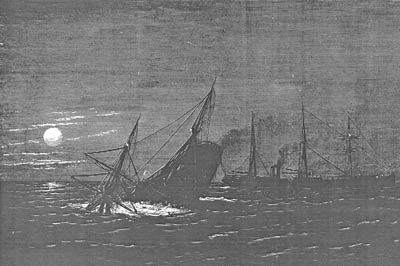 |
A drawing of the SS Bonnie Dundee and
the SS Barrabool colliding | Another drawing after the SS Bonnie Dundee and
the SS Barrabool collided |
The ships had been in sight for some time but at about 8 pm, the Barrabool collided with the SS Bonnie Dundee. The Bonnie Dundee was hit amidships on the starboard side, putting a huge dint at least one metre at the deck and holing her under the waterline. The ship filled with water extremely quickly and within four minutes, the SS Bonnie Dundee sank off Caves Beach, just south of Swansea. This is about 15 kilometres south of Newcastle.
Some passengers and crew leapt from the Bonnie Dundee onto the Barrabool but the cabin boy failed and fell instead into a lifeboat. He was killed when it was cut in two. Four women who were given life buoys and told to jump into the ocean refused and were sucked under when the ship sank.
 |
| A photo of the SS Barrabool in Newcastle Harbour after the collision |
The Newcastle Harbour Master sent the Government steamer, Ajax, to the scene to try the bodies of the lost but it was unsuccessful.
The Mate, T. Crawford, who was in command of the vessel at the time, was found guilty of negligence and had his Master's Certificate cancelled for 12 months. The ship was insured for 6000 pounds, but was said to be worth a lot more. The cargo was not insured.
The Barrabool later sank another ship, the Birksgate in 1884. By this time the ship had earned the nickname "The Great Australian Ram" and was said to steer so badly that other ships got out of her way when they saw her approaching. She ended up laid up in Sydney in 1912.
On Friday 21 March 1879, an inquiry into the death of Mrs David Brown, who died in the accident, closed after six days. The jury found that her death was caused by drowning on board the Bonnie Dundee owing to a collision brought about by the gross negligence of Thomas Crawford, mate and John Alexander Stuart, master. Both the captain and mate of the Bonnie Dundee were committed to be tried on a charge of manslaughter. The prisoners were given bail, each being ordered to find one surety in £300 and two in £150 each.
On Tuesday 25 March 1879, the Marine Board of Inquiry into the sinking exonerated Captain Stuart from blame in the sinking but found the mate, Thomas Crawford guilty. He was called upon to show why his certificate should not be cancelled or suspended. On Friday 28 March 1879 his certificate was suspended for 12 months.
On 1 April 1879 the Shipwrecked Seamen's Relief Society voted that £33 was to be divided between the captain, chief mate, and two seamen of the Bonnie Dundee.
On Friday 16 May 1879 Thomas Crawford was found not guilty of the manslaughter of Mrs Brown. Captain Stuart (reported as Stewart in at least one paper) did not have the charges against him proceeded with.
Today the Bonnie Dundee lies in about 35 metres of water about 5.1 kilometres off Caves Beach and about 4.4 kilometres from the mouth of Swansea Channel (the entrance to Lake Macquarie). To find the wreck, head out on about 115° once you have cleared the channel and Moon Island.
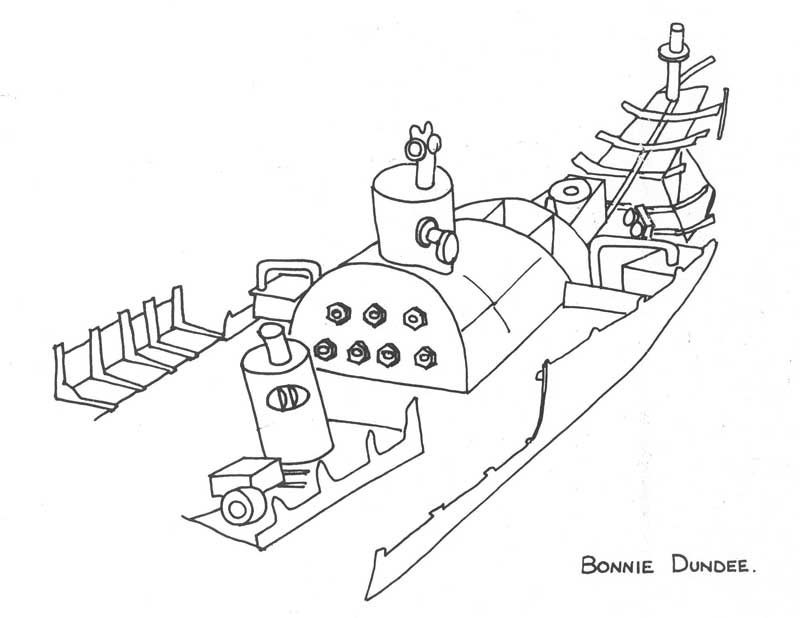 |  |
A diagram of the SS Bonnie Dundee by John Riley
John Riley Memorial Collection, Heritage Branch, OEH
Click on diagram to see larger sized version | Another version of the Bonnie Dundee diagram by John Riley
John Riley Memorial Collection - Heritage Branch, OEH
Click on diagram to see larger sized version |
The GPS mark for the anchoring spot is 33° 06' 25.6"S 151° 42' 10.2"E (note that all my GPS Readings are using AUS66 - if you use any other datum, you will need to convert the reading - see my GPS Page for more details). The wreck is not very big but it is quite easy to pick up on your depth sounder due to the huge amount of fish that live here. However, anchoring is a bit different, the small size of the site means that it can be hard to get the anchor to hook into the wreck. Adding to that, the wreck is in two pieces, the larger stern section and the smaller bow section. There is a gap of about 25 to 30 metres between the two sections. The wreck lies facing the north-east.
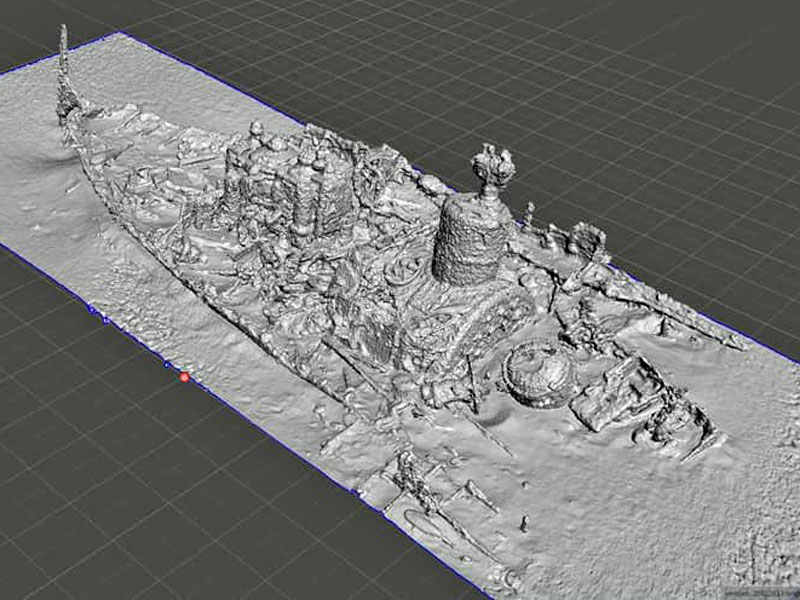 |
A digital 3D model of the wreck, stern at left
Created by Grant Thomas and used with his permission |
Once you have reached the wreck you will almost certainly be anchored on the stern section of the ship as this is the largest part of the ship. The boiler is not all that big and sits mostly clear of the sand. In front of the boiler there is a small donkey boiler which has probably fallen from above this location. On the top of the main boiler there is a very large steam dome. Behind the boiler is the steam engine. As mentioned above, this is a compound twin cylinder engine. The drive shaft from the engine cannot be seen as it is buried under the sand.
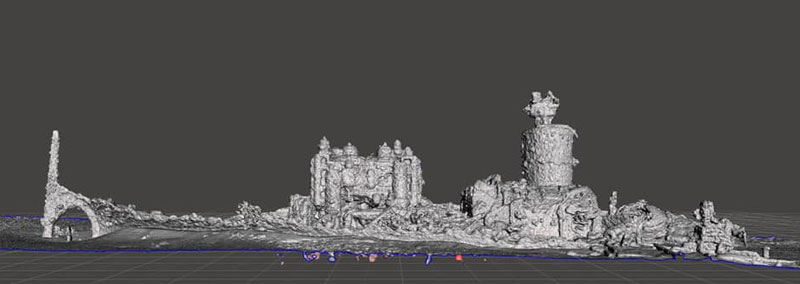 |
A digital 3D model of the wreck, stern at left
Created by Grant Thomas and used with his permission |
At the stern, you can see the steering gear and rudder. Under this is the propeller. Only part of one blade of the prop can be seen. Along this section of the ship the hull is mostly intact.
In front of the boiler the ship does not really exist. On the starboard side the is a small section of hull and on the port side there are three or four ribs protruding high above the sand. Everywhere else is just sand. If you swim out past these features and keep going in the same direction for about 25 to 30 metres you will come to the bow section of the ship. This consists of about five metres of ship. The bow is tipped over to starboard at an angle of about 45°. I did not see any anchors but there are lots of bits and pieces here.
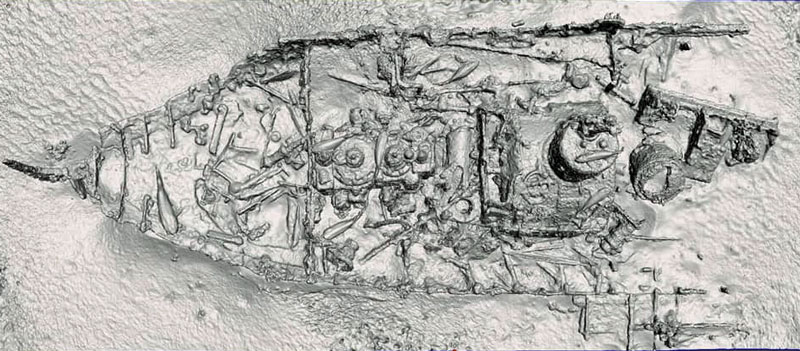 |
A digital 3D model of the wreck, stern at left
Created by Grant Thomas and used with his permission |
This wreck has some of the most prolific fishlife I have seen anywhere. It rates with the wrecks of the SS Tuggerah in Sydney and SS Lady Darling off Narooma. Huge schools of yellowtail, nannygai and seapike hang over the wreck and other fish like silver sweep, black reef and leatherjackets mix in with them. On the sand there are wobbegong sharks and in and around the boiler and engine there are huge moray eels.
As mentioned above, this wreck is about 35 metres deep and as such, not for inexperienced divers. You can dive this wreck with Aqua Zero Dive Centre at Swansea or Norah Head Divers Depot at Norah Head.
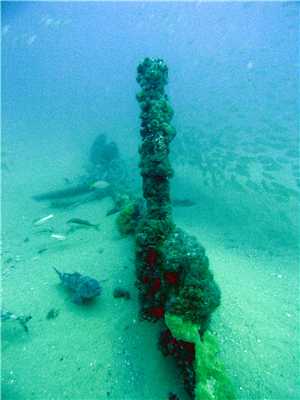 |  |
The port hull in front of the boiler
Photo by Peter Trayhurn | Preliminary drawings of the Bonnie Dundee by John Riley
John Riley Memorial Collection - Heritage Branch, OEH
Click on diagram to see larger sized version |
Other resources:
Interactive 3D model of main section of wreck
Interactive 3D model of bow section of wreck
References:
The Brisbane Courier - Friday 29 June 1877
The Brisbane Courier - Wednesday 11, Friday 13 and Monday 16 July 1877
The Brisbane Courier - Tuesday 26, Thursday 28, Friday 29, Saturday 30 November 1878
The Brisbane Courier - Monday 2, Tuesday 3, Wednesday 4, Thursday 5, Wednesday 11 December 1878
The Brisbane Courier - Wednesday 12, Monday 17, Saturday 22, Monday 24, Wednesday 26, Friday 28 and Saturday 29 March 1879
The Brisbane Courier - Wednesday 2 April 1879
The Brisbane Courier - Saturday 17 May 1879
Destination Never Reached by Max Gleeson pages 27-37 (excellent - see Max's Web Site)
Riley's Wrecks - The Top 20 Wrecks in NSW by John Riley in Scuba Action, Page 7 September/October 1986
North Coast Run page 158
Wrecks on the NSW Coast by Jack Loney, pages 71-2
Aqua Zero Dive Centre Web Site
Big River Nicolls
Free Settler or Felon Web Site
Australian National Maritime Museum Web Site
Encyclopedia of Australian Shipwrecks
3D diagram created by Grant Thomas, Messenger conversations dated 25 January 2021
Interactive 3D diagram created by Grant Thomas, Messenger conversations dated 14 March 2023
| 
 v6.00.307 © 2003-2005
v6.00.307 © 2003-2005